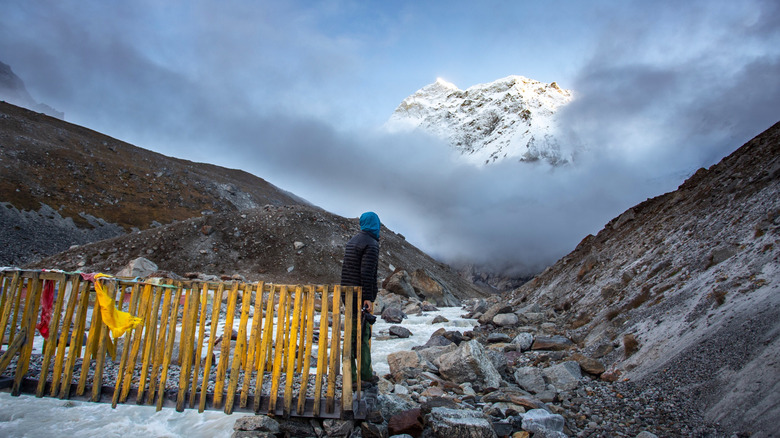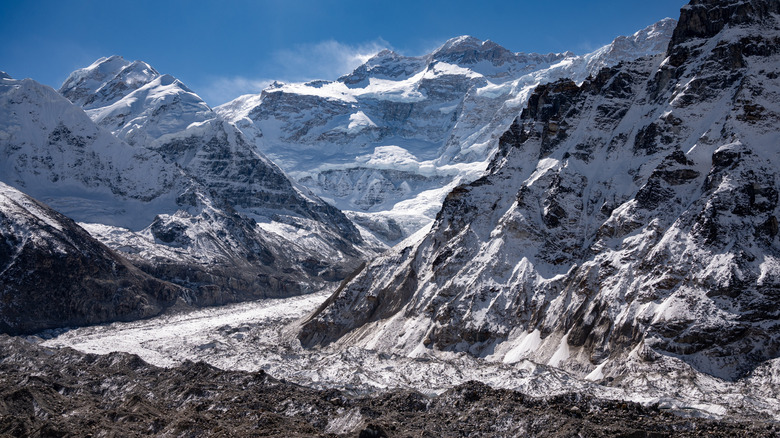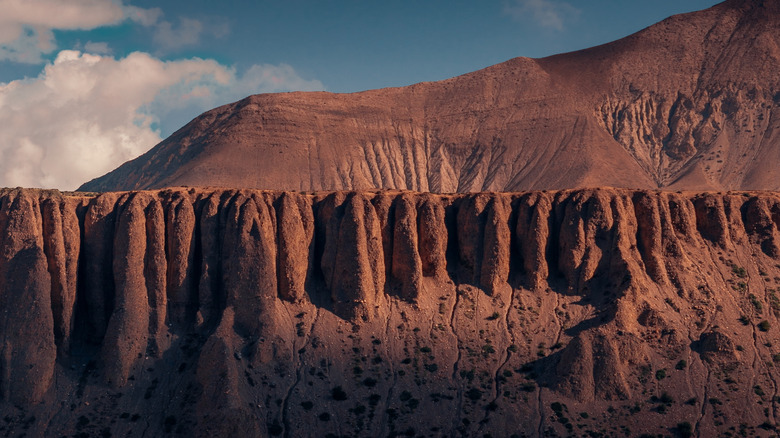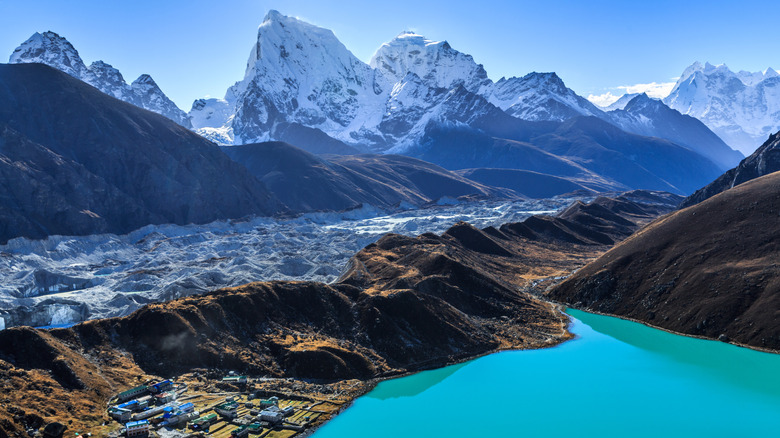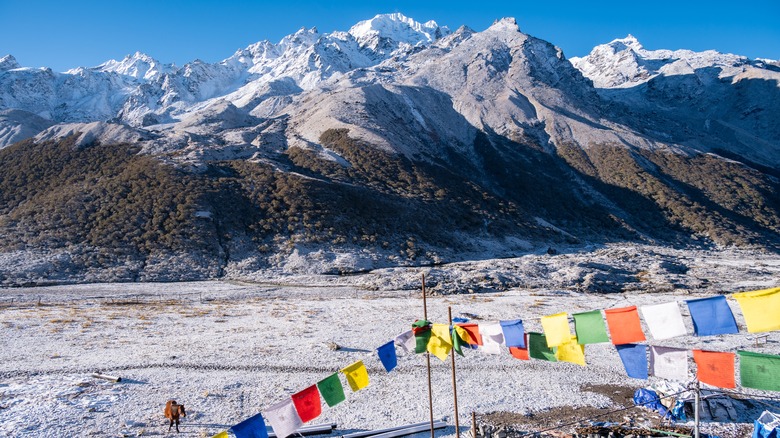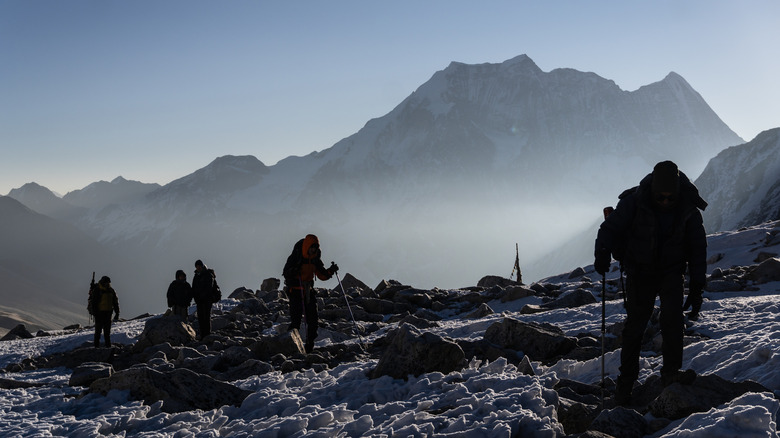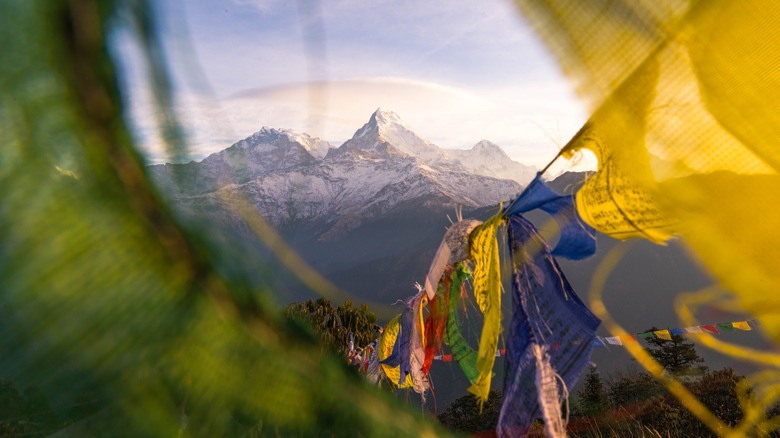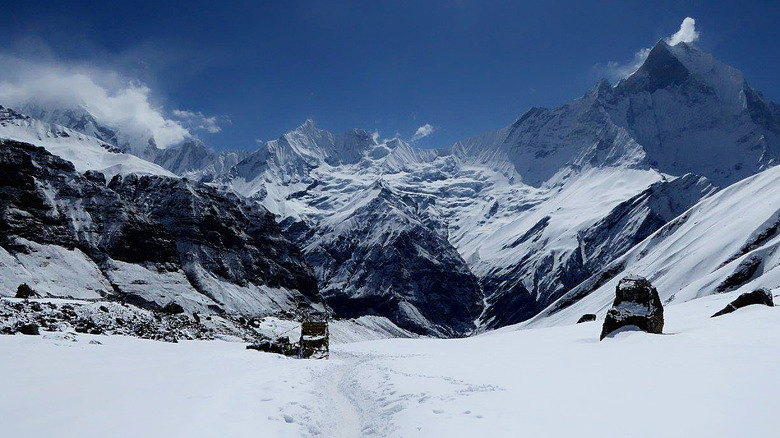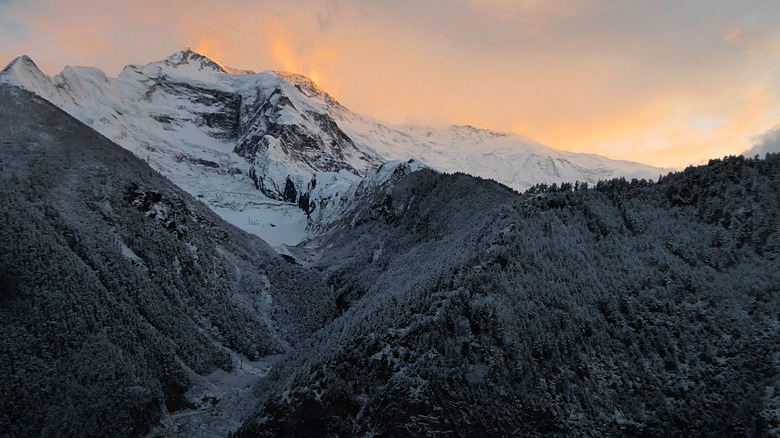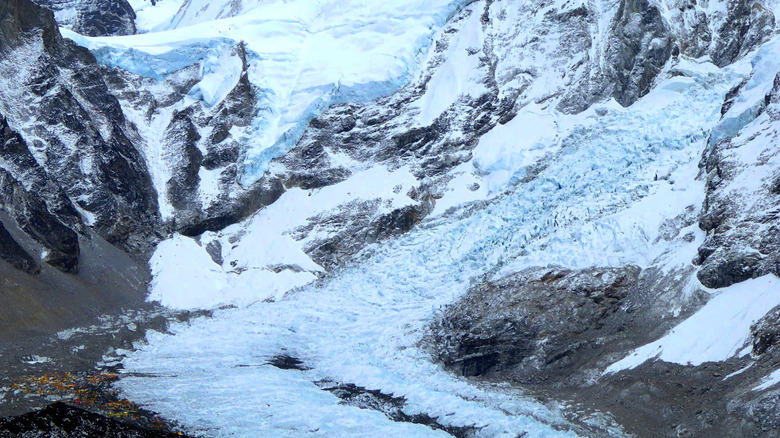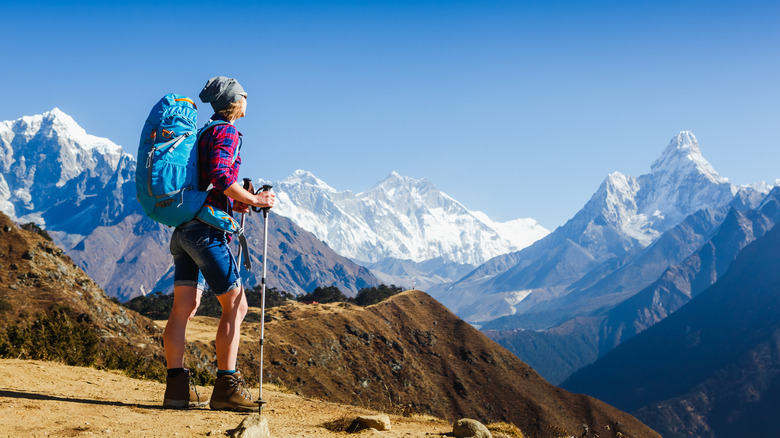10 Incredible Hiking Trails In Nepal
We may receive a commission on purchases made from links.
Craning your neck to see the peaks of impossibly high Himalayan mountains feels like a moment of pure disbelief. It doesn't matter if you've been to every other mountain range on Earth; if you haven't been to Nepal, then you surely won't believe just how high mountains can be. However, they're not only high. They are magnificent in shape and length, and the spirituality connected to them is an enlightening experience for many. Everest may be the granddaddy, but Nepal is home to many other mountains that could easily be considered wonders of the world.
Nepal boasts eight of the ten highest mountains on the planet, and there are treks throughout the country that allow you to get the best possible views of them all. Some of them are short day trips, while others are multi-week adventures. There are trails for all levels of fitness and experience, but hiking this network isn't for everyone. Facilities are minimal, and accommodation is mostly rustic, with teahouses offering unheated rooms and blankets that have often seen better days.
That said, hearty meals are shared around wood stoves, fostering a communal feel, and the Nepalese hospitality is something that lingers long after the memories of snow-capped peaks begin to fade. With a little research, you can easily have the time of your life enjoying the splendor of the Himalayas while feeling proud that you were able to give up some of your creature comforts. At least for a short time anyway. Through personal experience, traveler tales, and online reviews, we have compiled some of the best and most popular treks to experience while on a trip to Nepal.
Makalu Base Camp
The Makalu Base Camp trek is one of Nepal's more isolated and physically demanding routes. However, the rewards for taking it on are high, with trekkers treated to untouched wilderness and some seriously dramatic mountain scenery. This trek can take anywhere between 12 and 21 days, depending on your route and pace. On the way, the trail takes in beautiful rhododendron forests, Sherpa and Rai villages, the Barun Glacier, and panoramic views of Makalu, Everest, and Lhotse. It reaches a maximum altitude of 16,732 feet (5,100 meters), and the destination is the foot of Makalu, the world's fifth-highest mountain. This peak is shaped like a four-sided pyramid, and its heavenly ascent ends at 27,838 feet (8,485 meters).
Like much of Nepal, from mid-October to mid-November, the skies are clear and the majestic white peaks stand out brilliantly against the deep blue heavens. However, November starts to get a little more chilly, and between December and March, you may have the entire place to yourself — if you can brave the frigid temperatures. The weather starts to improve as the spring rolls in, but this is also the start of the Makalu climbing season. By April, the route is full of climbers, and it is the busiest time of the year for this area. However, visitor numbers still fall way short of the more popular trekking routes.
Kanchenjunga Base Camp
The Kanchenjunga Base Camp trek is another long and demanding route and takes trekkers to the foot of the world's third-highest mountain. Like Makalu, trekkers should be physically fit with prior high-altitude experience. It's such a remote and challenging trail that solo trekking is not permitted, and you must travel in a group of at least two people with a licensed guide. It reaches a peak elevation of 17,000 feet (5,200 meters) and covers a total trekking distance of 137 miles (220 km).
This trek is a loop that passes through remote Tibetan villages and Rai and Sherpa communities. It takes in rugged alpine terrain, jungle paths, glacial valleys, and high passes, and the keen-eyed also have the chance to spot rare wildlife like the red panda, snow leopard, or Himalayan black bear. The loop links both the north and south base camps, with the clockwise route recommended for better altitude acclimatization. There are spectacular views of Kanchenjunga towering above at 28,169 feet (8,586 meters), while sweeping views of Jannu, Kamnachen, and the Kabru range are also on offer with dramatic skylines of glaciated ridges, jagged peaks, and remote high-altitude wilderness.
Like most of Nepal, summer should be avoided unless you're a fan of leeches and landslides. It's the autumn season that sees the most trekkers, with late October to early November hitting peak numbers. However, these numbers are even fewer than the Makalu trek, so it is considered a remote and authentic Nepali trekking experience.
Upper Mustang
This trek ventures into the heart of what was once a restricted kingdom and offers a rare glimpse into Nepal's Tibetan culture and its desert-like Himalayan landscapes. The dry, high-altitude plateau of this area is beautifully framed by the towering snow-capped peaks of the Annapurna and Dhaulagiri ranges. However, wind-sculpted sandstone cliffs, eroded canyons, and dramatic desert landscapes dominate the scenery, making it very distinct from the lush greenery you might be accustomed to from other trekking routes in Nepal. Ancient monasteries reflecting deep-rooted Tibetan Buddhist traditions are scattered throughout, adding more than a touch of spirituality and cultural depth to this journey.
The Upper Mustang route is usually a 10-day hike covering around 100 miles (160 km). However, some trekkers opt for longer trips of up to 16 days. It's suitable for those with moderate fitness, although there are some challenging points. The elevation ranges from 9,200 to 14,107 feet (2,804 to 4,300 meters), and visitors must trek in a group of at least two people with a certified guide leading the way.
A permit is required for a 10-day trip, and at $500 per person, it's not particularly cheap. Longer trips require a further $50 per day. However, this does help deter an oversaturation of visitors to the area, meaning it's another trek where you will undoubtedly have soul-stirring moments to yourself. It's also one of the few treks in Nepal you can do during the monsoon season because the Upper Mustang trail is in a rain shadow, making the weather much drier than other parts of the country at this time. However, the temperature can get high, making daytime hikes a little on the sweaty side.
Gokyo Lakes
The Gokyo Lakes trek is often combined with or used as an alternative to the Everest Base Camp trek (EBC). The first part follows it to Namche Bazaar, where it is recommended to take at least three days of rest to acclimatize. This buzzing little town sits on a natural amphitheater carved into a steep mountainside surrounded by towering peaks. There's plenty to do here during your stop, including fascinating museums, an Everest viewpoint, and even a few bars, including what is claimed to be the world's highest Irish pub.
However, that's not what you're here for! After Namche Bazaar, the hordes continue off on the EBC trek, while you and a select few venture onward to Gokyo Lakes. This trek is not particularly hard and is suitable for anyone with moderate fitness. However, the altitude can be challenging, and it's essential to go slowly, with a 984-foot (300-meter) rise in elevation per day being the recommended maximum.
The trek reaches an elevation of 17,575 feet (5,357 meters) at Gokyo Ri, a viewpoint above Gokyo Village that takes in incredible views of Everest, Lhotse, Makalu, and Cho Oyu, the first, fourth, fifth, and sixth highest mountains on Earth. The area also includes the world's highest freshwater lake system with six glacial-fed turquoise lakes and Ngozumpa Glacier, which is the longest in the country.
Langtang Valley
Nearby Nepal's largest city and capital of Kathmandu, is the Langtang Valley trek, which offers majestic mountain views, green forests, alpine meadows, peaceful river backdrops, and quieter trails than the country's more popular routes. From lush, forested foothills, trekkers ascend to rugged alpine terrain. Once past Langtang village, the valley opens up to reveal dramatic vistas of snow-capped peaks with panoramic views across the Langtang Lirung range and surrounding mountains. You'll encounter colorful prayer flags and intricately inscribed mani walls, while sacred chortens also decorate the area, especially around Langtang village and Kyanjin Gompa.
Langtang Lirung and Langtang II dominate the landscape here. They may not break the top 10 highest mountains in the country, but they are still an imposing sight from below in this glacial valley. The trip is suitable for all trekkers of moderate fitness, but it does ascend to 15,092 feet (4,600 meters). There's also an optional strenuous side hike to Tsergo Ri, which reaches 16,512 feet (5,033 meters). This means following acclimatization rules is essential, while sustained climbs and steep stone steps add to the altitude challenge. But in general, the trail is manageable for all, and at 7-10 days in length, it's ideal for anyone looking for a quick escape to nature not far from the capital.
Manaslu Circuit
This one is a bit of a toughie. While being an experienced trekker isn't a requirement, you'll need to be in good physical condition to get through the Manaslu Circuit. This challenging 14-18-day hike takes in 110 miles (177 km) of steep, rugged terrain with long daily distances and high altitude, while the weather can throw in the occasional curveball. That said, the circuit follows the same weather patterns as the rest of the country, making spring and autumn the optimum times to visit, while the teahouses are of a decent standard.
A licensed guide is required due to the area's restricted status. The Nepali government does its best to preserve the unique culture in areas such as this, and the guide requirement and additional weekly permit of $75-100 do put some trekkers off. However, that is their loss. The 2,000 or so annual visitors who do make this circuit are in for quite a treat. It follows the Budhi Gandaki River valley and encircles the world's eighth-highest peak, Mount Manaslu, which towers above at 26,781 feet (8,163 meters).
It begins in lush, low-altitude forests with unnerving suspension bridges crossing narrow gorges before opening up into stunning alpine terrain of colossal summits, dominated by Manaslu. The highest point is Larkya La Pass, which offers dramatic panoramas at 16,751 feet (5,106 meters). While this does mean you need to pay attention to acclimatization, the elevation gain is quite gradual, with fewer abrupt climbs.
Poon Hill
Poon Hill is ideal for beginners or those with limited time, but because of the stunning panoramic views of the Annapurna and Dhaulagiri ranges, it's often crowded. The hike is easy to moderate, with daily treks of up to six hours. There are a few steep ascents, especially the Ulleri stairs on the first day (or second, depending on your itinerary). You'll likely stay that night in the village of Ulleri, which sits atop this uneven staircase of more than 3,000 steps. Having done this climb twice myself, I can confirm that it is more manageable than it sounds, but you may want to go slowly if you're not in peak condition. The good news is that there are some comfortable and welcoming guesthouses at the top.
Throughout the journey to Poon Hill, you'll pass through lush forests, waterfalls, and Gurung and Magar villages. After Ulleri, you'll catch views of Annapurna and Machapuchare, the distinctively shaped mountain also known as Fish Tail. Upon reaching Poon Hill, you'll be treated to an astonishing 360-degree panorama of Himalayan titans. Just make sure you wake up early enough for the indescribable sunrise.
This is the highest point in the trek at 10,531 feet (3,210 meters). Altitude sickness is a low risk at this height, and afterwards it's a fairly easy hike back down to Birethanti to drive back to the charming lakeside town of Pokhara. There you can take the adventures further by paragliding or riding one of the world's most thrilling ziplines at Sarangkot. Alternatively, you can push on to the hot springs at Tatopani and soak your tired bones, then move on to Ghandruk, a culturally rich Gurung village with traditional stone houses, cobbled paths, and surprisingly good facilities for weary travelers.
Annapurna Base Camp
If you take the Tatopani hot spring option after Poon Hill, you can easily access the Annapurna Base Camp trek from there (or Ghandruk). Also known as ABC or the Annapurna Sanctuary Trek, it takes you deep into the heart of the Annapurna massif and rewards you with close-up panoramic views of the range's rugged elevations. This was one of my first treks in Nepal, and I found it to be a fairly moderate hike. It wound through dense forests and bamboo groves, climbed up and down steep stairs — especially the Ulleri stairs—and continued past waterfalls, the occasional hot spring, and across suspension bridges spanning rivers far below. Stunning views of Machapuchare, Annapurna South, and Hiunchuli are on offer along the way without trekkers reaching too high an altitude. The maximum reached is 13,549 feet (4,130 meters), which is okay for most people but can still cause issues if you ascend too quickly.
Upon reaching base camp, the views were sublime, and I left with a feeling of quiet disbelief. That was, however, until I suffered a bout of snow blindness. The bright sunlight must have reflected off the fresh snow, making it painful to both open and close my eyes. It was a long night, but thankfully I was mostly healed by the morning. However, I strongly recommend a good pair of sunglasses with full UV protection when trekking anywhere in Nepal. Just make sure they aren't the ubiquitous knockoffs that are so tempting to buy in Kathmandu.
Annapurna Circuit
While this route has changed in parts due to road construction, it is still epic and full of wonder, passing through a variety of landscapes as you ascend and descend. If you prefer to avoid the road, a little research can take you on alternative routes, although it can't be avoided completely. On the eastern side of the circuit's highest point, the Thorong La Pass, you can now drive as far as Manang at 3,540 feet (11,614 meters). On the western side, it reaches Muktinath. While this has created a bit of a loss to the trek's traditional remoteness and cultural authenticity, it has also improved accessibility and created more economic opportunities for locals.
However, driving to either Manang or Muktinath to then tackle the pass is strongly discouraged. It is too high in altitude, and a drive there means a quick rise in elevation, which means a high risk of altitude sickness. Nowadays, most people start the trek at Chame at 8,760 feet (2,670 meters). However, having done this trek myself, I thoroughly recommend the original starting point at Besisahar, lower down in the lush valley, and enjoying the full loop if you have the time.
The Annapurna Circuit takes around 12-22 days, but if you're not in a hurry, you can take as long as you like and link it with other trails along the way. Facilities are excellent; there is even some luxury accommodation dotted throughout. Manang has a cinema (of sorts), and you can pick up some cash at reliable ATMs in Chame and Jomson. The latter even has an airport if you've had enough and just want to get back to creature comforts in Pokhara or Kathmandu.
Everest Base Camp
The Everest Base Camp trek (EBC) is Nepal's blockbuster trail and one that appears on bucket lists around the world. While challenging, it can be done by anyone with moderate fitness. You'll be surprised by how fast your body adapts and builds the necessary muscle and stamina to get through it. The trek begins with an exhilarating (some may say terrifying) flight from Kathmandu to Lukla. The small Twin Otter you'll fly on cruises Indiana Jones-style between towering mountains before dropping into a narrow valley. It then lands on a short, steep runway perched on a ridge. With mountains towering all around, it screeches to a halt just before a massive cliff face in front of the plane. The country may not be home to any of the safest airlines in the world, but who would want to miss out on this thrill? However, if it doesn't appeal, you can also walk this part, and many travelers recommend doing just that.
From Lukla you'll climb to Namche Bazaar, where you must stop for a few days for acclimatization, and then it's on with the world's most famous trek. You'll get occasional glimpses of Everest as you gradually climb through the high-altitude terrain. You'll pass traditional Sherpa villages like Tengboche, Dingboche, and Lobuche, and the views of stunning peaks like Ama Dablam, Lhotse, and Everest itself get increasingly dramatic. You'll follow the Khumbu Valley, weaving through forests, windswept plains, and glacial moraines before reaching the grandest site of all: Mount Everest. An interesting fact about Everest Base Camp is that the views can be a little underwhelming. I recommend a climb up Kala Patthar if you have the energy. Even the greatest writer or photographer will struggle to do the views justice from there.
Methodology
To compile this list of top treks in Nepal, we used a combination of personal experience and knowledge acquired through other trekkers. We also scoured the internet on sites like Reddit and TripAdvisor, as well as Facebook groups and respected blogs, such as whirled-away.com and mountainswithmegan.com, to gain knowledge from other experienced trekkers. Lastly, we browsed the websites of Nepalese tour operators to find the most popular routes they offered and took the reviews left by their customers into consideration, too.

